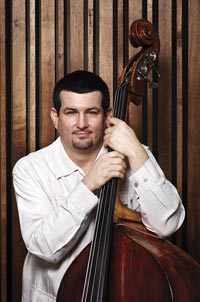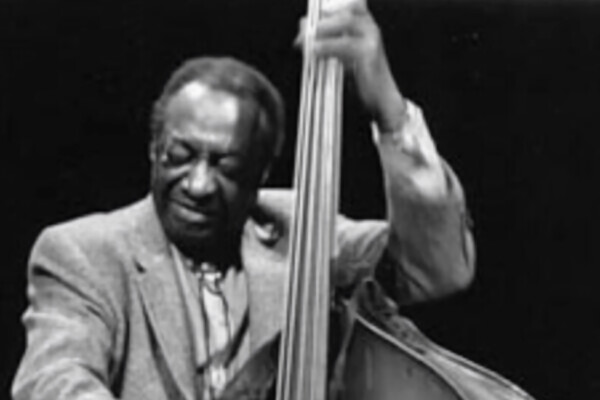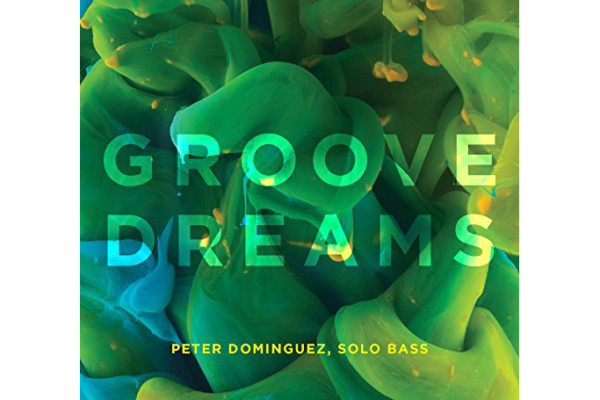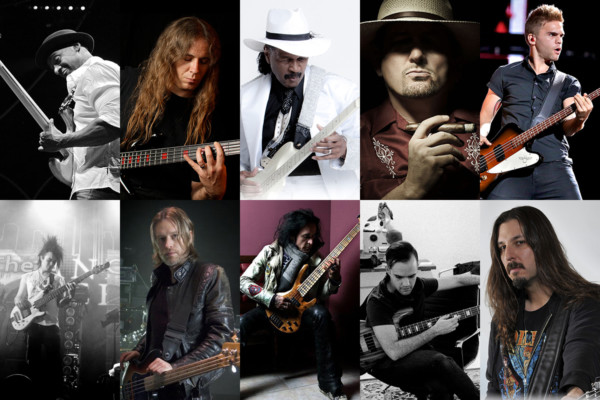An Interview with Peter Dominguez
 Peter Dominguez is a man that has been steeped in music for his entire life. With a pianist for a father, the double bassist grew up learning music throughout his formative years, ultimately leading to an intimate understanding of his instrument. Dominguez currently shares that understanding as a professor at Oberlin Conservatory where he proudly teaches Double Bass and Jazz Studies. Not restricted to education, he has been an in-demand bassist during his illustrious career, working with artists ranging from Tommy Flanagan to Della Reese.
Peter Dominguez is a man that has been steeped in music for his entire life. With a pianist for a father, the double bassist grew up learning music throughout his formative years, ultimately leading to an intimate understanding of his instrument. Dominguez currently shares that understanding as a professor at Oberlin Conservatory where he proudly teaches Double Bass and Jazz Studies. Not restricted to education, he has been an in-demand bassist during his illustrious career, working with artists ranging from Tommy Flanagan to Della Reese.
We met Dominguez at the 2011 Bass Coalition Summer Workshop, where his clinic and show-stopping concert wowed attendees. We took the opportunity to interview the veteran bassist on his background and his tips on how to grow as a musician.
You were raised in a musical family with lots of siblings. How did that affect your development as a musician?
My family has had a profound affect on my career and continues to provide core values of sharing and joyous playing. Growing up with three floors of music where everyone vocalized and studied an instrument does have its advantages. Family members that are active professionally include Dad: Frank (DeMiles) Dominguez who continues to sing and play piano throughout Southeastern Wisconsin. Brother James plays drums in a Milwaukee Firefighter’s band. Brother John just relocated to the LA area and is playing some great dbass. Susan Carol is a NYC violinist and successful studio teacher. We (Susan and I) toured Europe throughout the 90’s with the American Sinfonietta and had many great experiences on and off the stage. Most recently Frank DeMiles and Friends performed at the Milwaukee Italian Community Center featuring John and myself. Along with Dad and Brian Ritter (drums), everyone had a great time experiencing stereo dbass. We closed the concert doing a blues where John and I played four hands on one double bass. It brought the house down.
One of your biggest mentors is Richard Davis, who many people don’t realize is one of the most recorded bassists of all time. How did that come about, and what’s some of the best advice he gave you?
Many don’t realize Richard Davis’s contributions to the bass playing in addition to the depth and scope of his recording career. It’s something to really check out. I first met Richard on vinyl, in 1974 while I was studying at the University of Wisconsin and being somewhat pressured to choose either Classical or Jazz. I went to see Prof. Jimmy Cheatham, and he promptly pulled out RD’s Philosophy of the Spiritual and said something like, “you don’t need to choose, just play it all like RD”. That moment changed my life, and Richard became my model.
I started listening to his prolific recordings with Sarah Vaughn, Booker Irvin, Eric Dolphy, Andrew Hill, Vanguard Orchestra, Oliver Nelson, etc. and am still discovering. The latest; RD w Joe Henderson on “Mamacita” -it’s a brave new world! He arrived in the fall of 1977 and I was awestruck for some time. I do remember the Grammys or Academy Awards were on TV in the late 70s and there was my teacher, RD, visible in the orchestra and I had just had a lesson with him. The sheer command of the bass he would demonstrate in our lessons blew my mind! In 1980, I became Richard’s assistant in Bass and Black Music and finished my master’s studies with him in 1982.
Like most students of the bass, I struggled with inconsistencies while working on Sevcik and Simandl. Becoming frustrated, I asked RD how to improve my “bad days” of playing. He asked me if I had eaten, if I had a good pair of shoes, if I had warm clothes to wear, if I had a secure apartment, etc… I answered affirmative. He then said that I needed to address the bass with essentially the same expectations and quality as my daily activities. “If you take care of the bass, it will take care of you.” Needless to say and over 31 years later, I’m still following his advice.
Richard Davis continues to amaze me with his insight, courage, energy, and openness. As a mentor, and colleague, we have remained close throughout the years. I’ve been coordinating the Richard Davis Foundation for Young Bassists conferences, of which the 19th will be held on April 6th and 7th, 2012 in Madison, WI. Richard hosts many great bass players and teachers at these conferences. It is considered the premier bass experience for bassists age 3-18 and continues to transform many young bassists and their families.
You’ve been teaching at the college level for much of your career, and as a result you’ve had tons of students. What is the biggest issue you see in growing bassists?
To be honest, the early days of university teaching was a challenge. I’ve been fortunate to have a steady flow of talent come my way. Many former students keep in touch and are doing well. Joining the professors that include Martha Illgenfritz and Carl Donakowski will be Matt Hughes and Philip Alejo this year at Western Illinois University and University of Michigan respectively. Ben Jaffe and Andy Wolf are holding things together in New Orleans while Brady Kish, Nate Brenner, Alex Frank and Matt Mueller are on the west coast. Bob Rowher, Jon Luebke, Ed Fedewa, David Rosin and Emma Dayhuff are in the Midwest. Matt Schnieder, Steve Wood, Rob Adkins, Ryan Kotler, Jackson Hill, Zach Hickman, James Blachly, Moppa Elliot and Chris Mees are all doing some exciting things on the east coast. Curtis Ostle and Mike Brownell are playing full time in Shanghai, China. Also Matt Asti of MGMT and Brian Chase of Ya Ya Ya’s studied at Oberlin.
Growing bassists or young bassists need to gain strength in their fingers, hands, arms, back, legs and feet. It’s all support for the fingers that connect either to the ears (aural) or eyes (written). Technical work is required to gain finesse for long term playing.
Be careful of mechanical playing that doesn’t have personality coming through. I want to hear voice and expression more than vocabulary and impression. But then again it’s the sign of the times and correlates to keyboarding, texting and Twitter, and the decline of cursive writing. The lines and curves in cursive writing between the letters represent the connectedness of the notes and melodies.
To “grow” bassists, I see the need for school music systems to address the set-up of their school double basses. Think about a beginning student trying to hold down their first C natural on the A string with a nut about 1/4″ high and the metalcore strings are two inches off the fingerboard. Unfortunately, that’s too often reality.
What’s your overall teaching philosophy?
Demonstrate my love for the music and the performance practice of the double bass. Create trust and transform students through industry, nourishment, and exercise to help them find their passions and have their voice emerge.
In your opinion, why is it important to study bass in a higher education setting? What’s the most important thing students get out of it?
The Double Bass is a difficult instrument, and if not approached correctly, can lead to numerous occupational hazards and potential problems in your hands, arms, back, body, hips, ankles, knees, feet. It may take one, two, three or more – or in my case, eight – teachers that have informed a bassist’s approach to playing. After going to school to play, listen, study, write, arrange – absorbing it all, you will be a better all around person.
You’re well known in jazz and classical settings, but you also love a variety of genres and artists like Frank Zappa. Do you see diversity as a key to success?
Yes, diversity because you are always learning new songs, grooves, lines and forms. The double bass is an instrument that provides foundation for so many ensembles. For me, wherever those bass lines go, I’m checking it out and its all equal opportunity!
So you morph to fit any group, but do you have a favorite musical setting?
Well I hope that there will be many more musical settings coming my way. But if I were to choose one, it would have to be a trio with piano and drums.
At the Bass Coalition Summer Workshop, you talked about band interaction as “locking up, in and out.” Can you expand on that?
The concepts of Locking Up, In & Out in ensemble playing are attributed to drummer and MSU professor Randy Gelispie. As it applies to us bassists, we want to lock “up” with the drummer in time and lock up with the pianist in note choice. If there are soloists, we listen to their shapes and lines and try to lock up with contour, reharmonizations, alterations, pedals, etc. When this begins to process, the players are open with trust and respect, and creative sparks start to sound, that’s “Locking Up.” It represents a true democracy in the music.
Now when the pianist plays one of those left hand boogey woogey bass lines on the piano, there’s really nothing we can do to accompany or complement that line, so that locks the bass line “in.” Pianists lock us in with bass note choice just as drummers lock us in with their bass drum. When they play “four on the floor” [like] “boom-boom-boom-boom,” there is no choice but to lay down some heavy carpet. Locking in is ok and sometimes it’s the best choice for crafting the music but not the best for creating.
The default mechanism is Locking Out. That’s where something is not working; note choice, groove, intonation, etc and we lock “out” the perpetrators for the survival of the music. Once you apply the awareness of these concepts to ensemble playing and listening to recordings, it really helps with deep sensitive listening.
With 40 years on the bandstand, what tips would you give players starting out and wanting to build a career?
Find communities and begin immersion into scenes and cultures. Be sincere and compassionate; value the people and music; become active and play everything, but sing your song. Understand the difference between playing music for commerce and Art. As Nadia Boulanger told Quincy Jones, “the music can never be more or less than the creators are as human beings.”
You must have tons of gig stories… have one you’d like to share?
[I was] with Della Reese in Flint, Michigan. We were having an afternoon rehearsal and it became clear that the guitarist and drummer could not read the music nor provide the proper groove aesthetic. Della was so gracious. After about hour into the rehearsal, she decided the guitarist and drummer needed some nourishment to get through her music and ordered lunch for the entire band. After these guys finished eating, she fired them and turned to me to hire some “cats” from Detroit. They showed up minutes before the concert and read it down. Della was great as always and the band was swinging.
What’s your take on how the music industry has changed since you began playing?
My focus has been and continues to be about the music. So much about the music industry has changed with regards to production, technology and access. “Generation M” has much to sift through, but I believe everything still comes down to musical value. If you can play in real time on an instrument with a sound and a point of view, people will always listen.
What’s next for you?
I am working on a solo recording project called Bass Salute which includes some originals along with arrangements of Jazz and Latin standards. I performed some of this music at the Bass Coalition/National Jazz workshop concert last month. I’m enjoying the challenge of “21st century bass” – processing the melody line with a bass line and voice leading.
Another Josh Rzepka CD should be out soon and I’ll be performing in “the Contemporary Jazz Trio” with Billy Hart and Dan Wall in Cleveland in Feb. 2012.
There are a few other groups that I have been active with around the Northeast – Singer Ki Allen and friends that includes the guitar legend Bob Fraser and Ronnie Godale on drums. Also a latin jazz group with Jackie Warren on piano, Sammy DeLeon on congas and timbales, and Ronnie es muy caliente!
Photo Credits: Matt Perko.



